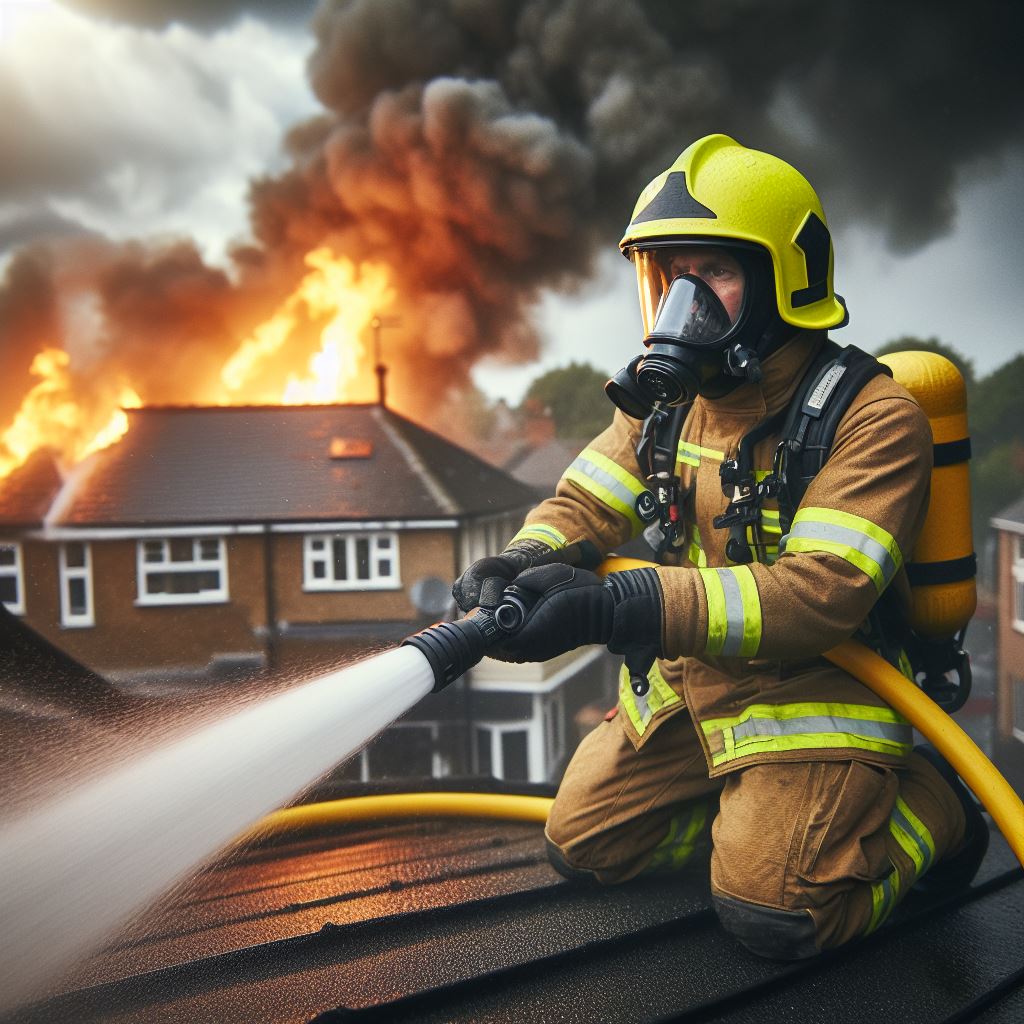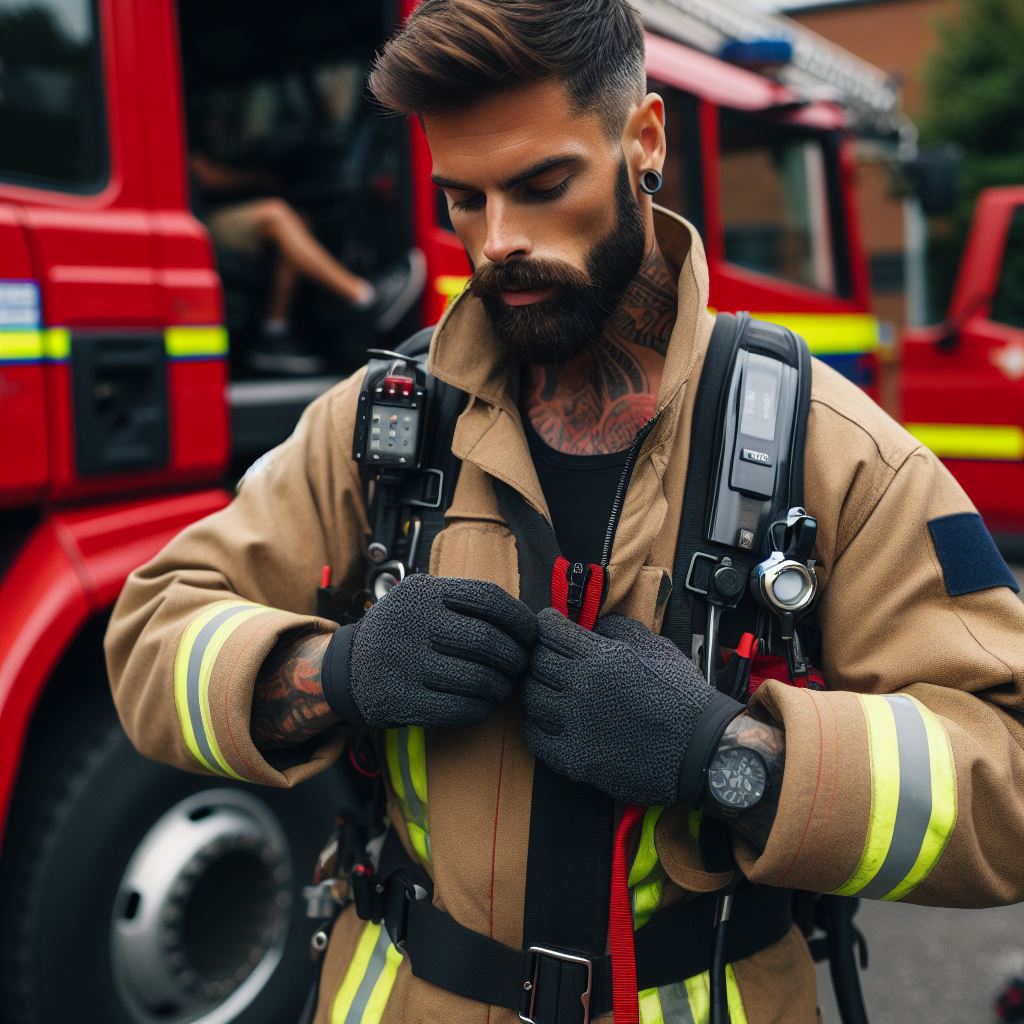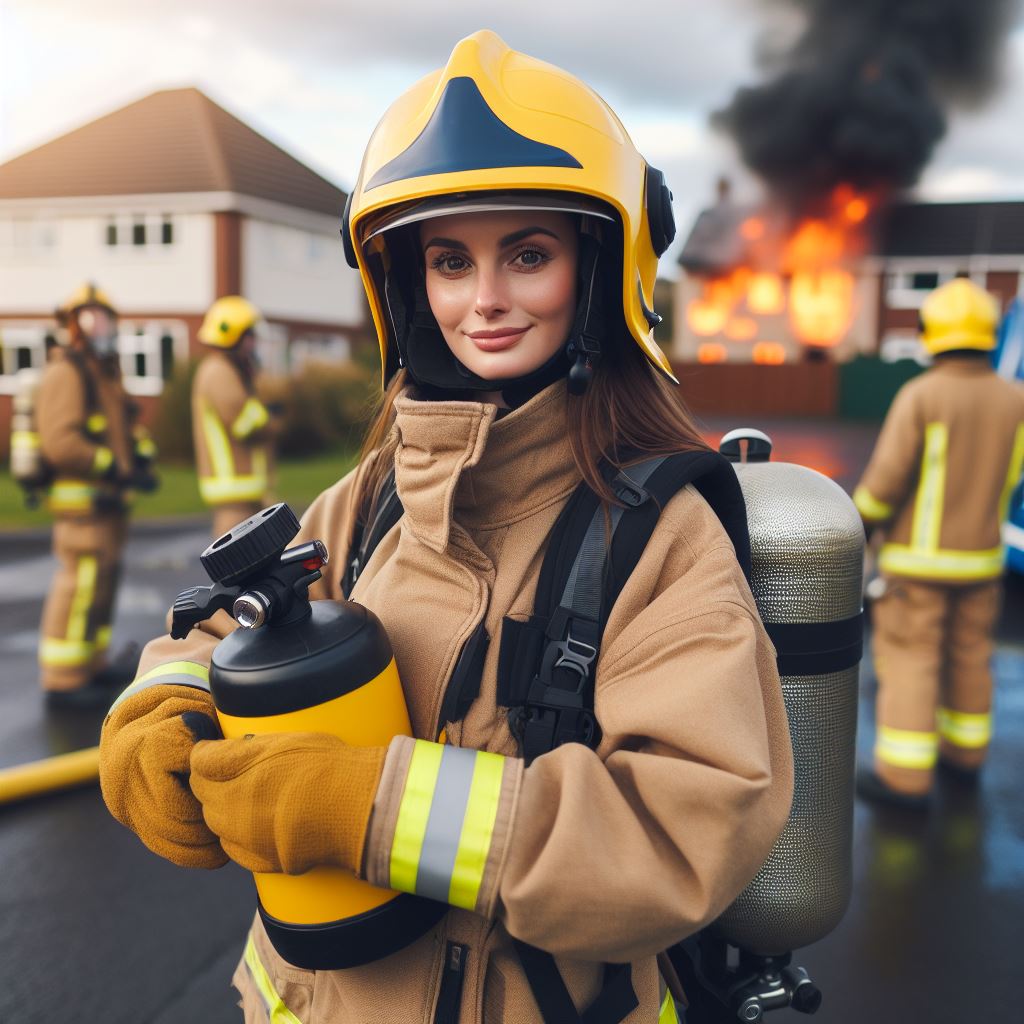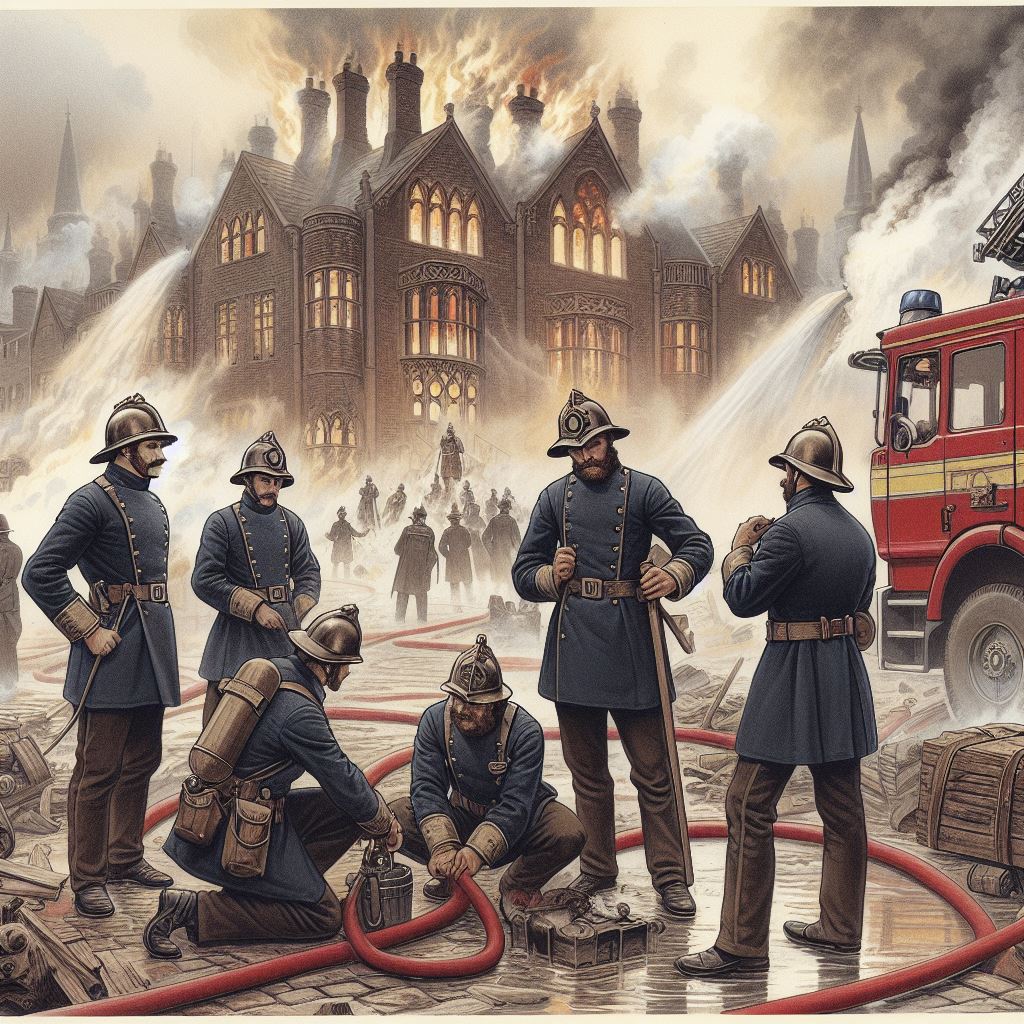Introduction
A day in the life of a UK firefighter is filled with importance, challenges, excitement, and adrenaline. It is a profession that requires bravery, skill, and selflessness.
Firefighters play a crucial role in protecting lives, property, and the environment from the devastating impact of fires.
Every day, they face unpredictable situations where split-second decisions can make a difference between life and death.
The adrenaline rush associated with a roaring fire, the sound of sirens, and the urgency to save lives create a unique experience for these courageous men and women.
In addition to fighting fires, firefighters also respond to other emergencies, such as rescuing people from accidents, providing medical aid, and hazardous material incidents.
They constantly train to improve their skills, physical fitness, and mental agility to handle any situation that comes their way.
Moreover, the job of a firefighter is physically demanding, requiring endurance and strength to carry heavy equipment, climb ladders, and break through doors.
They also have to work under extreme conditions, facing intense heat, smoke, and hazardous substances.
Despite the challenges, the profession of a UK firefighter is highly rewarding as they have the opportunity to save lives, make a difference, and serve their communities.
Their commitment and dedication make them everyday heroes, deserving of our respect and admiration.
Next, we’ll explore a UK firefighter’s daily routine, covering their responsibilities, training, and the diverse situations they face regularly.
Role and Responsibilities of a UK Firefighter
In the United Kingdom, firefighters play a crucial role in responding to emergencies and protecting lives and properties.
Their primary duty is to safeguard the community by swiftly and efficiently handling various situations, including fires, rescues, and providing first aid.
Let’s delve into the day-to-day tasks and responsibilities of these remarkable individuals.
Different tasks firefighters are responsible for
Responding to Emergencies
The foremost duty of a UK firefighter is to respond promptly to emergency calls.
Personalized UK Career Consulting
Receive tailored career guidance designed just for you. Get actionable steps and expert support to boost your career in 1-3 days. Take control of your career now.
Get StartedThey must be prepared to address a wide range of incidents, including structural fires, vehicle accidents, hazardous material spills, and natural disasters.
When alerted, firefighters quickly spring into action, ensuring their readiness to protect lives and mitigate property damage.
Upon reaching the scene, their immediate task is to assess the situation and determine the most effective strategy to control and contain the emergency.
They tirelessly work to combat flames, control smoke, and rescue individuals in peril.
Firefighters are trained to operate advanced equipment, such as fire hoses, breathing apparatus, and hydraulic tools, to carry out their duties effectively.
Rescue Operations
In addition to fire suppression, firefighters are responsible for conducting rescue operations.
They are trained to rescue people who are trapped or injured, whether it be during a fire, a car accident, or a natural disaster.
With their physical fitness and specialized training, firefighters navigate hazardous environments and employ various techniques to safely extract individuals from dangerous situations.
Firefighters undergo rigorous training programs to acquire the necessary skills for extricating people from vehicles, collapsed buildings, or other precarious environments.
They work meticulously to provide aid, stabilize injuries, and ensure the safety of everyone involved.
Their selfless dedication often makes the difference between life and death in critical situations.
First Aid and Medical Assistance
Apart from fire suppression and rescue, firefighters are also often the first responders in medical emergencies.
They provide vital first aid until paramedics arrive, contributing significantly to improving the chances of survival for those in need.
Firefighters are trained in cardiopulmonary resuscitation (CPR), performing basic life support, and administering various medical interventions.
Your Dream Job Starts with a Perfect CV
Get a tailored CV and cover letter that captures your unique strengths and stands out in your industry. Let us help you make an unforgettable first impression.
Get StartedWith quick response and thorough training, firefighters lead in delivering crucial care for cardiac arrests, severe injuries, and medical emergencies.
Their ability to act swiftly and confidently, even in stressful situations, is a testament to their professionalism and dedication to saving lives.
Importance of teamwork and cooperation in the firefighting profession
- The firefighting profession heavily relies on teamwork and cooperation.
- Firefighters work closely as a team, with each member assigned specific roles and responsibilities to ensure efficient operation and maximum safety for all involved.
- They foster strong and reliable relationships, built on trust, which is vital in emergency situations.
- By effectively communicating and coordinating their efforts, firefighters achieve optimal results.
- Whether battling intense flames or rescuing individuals, their ability to work in harmony enhances not only their own safety but also the safety of those they protect.
- The significance of teamwork cannot be overstated as it enables a smooth and well-coordinated response to emergencies.
In short, UK firefighters respond to emergencies, protect lives and properties, perform rescue operations, and provide essential first aid.
Their commitment to teamwork and cooperation ensures effective incident management and maximizes the potential for saving lives.
These brave individuals dedicate themselves to the service of their communities, often putting their own lives at risk to keep others safe.
Read: Specialist Roles within UK Police Departments
The Training and Qualifications Required
Becoming a firefighter in the UK involves a combination of educational qualifications, rigorous training, and continuous professional development.
Educational qualifications needed to become a firefighter in the UK
To begin with, it is important for individuals to have a good secondary education.
A solid educational foundation provides firefighters with the knowledge and critical thinking skills necessary for the job.
Once the educational requirements are met, aspiring firefighters must undergo a comprehensive training process.
This process helps them develop the skills and abilities required to handle various emergency situations with efficiency and professionalism.
Rigorous training process
Physical fitness is a crucial aspect of firefighting. Firefighters need to be strong and physically capable of handling the physical demands of the job.
They undergo regular fitness assessments and training to ensure they maintain optimal fitness levels.
Training is not limited to physical fitness alone.
Optimize Your LinkedIn for Success
Boost your LinkedIn profile with a professional bio, keyword-rich headline, and strategic recommendations that attract recruiters. Stand out from the crowd and get noticed.
Optimize NowTrainees also engage in theoretical learning, where they acquire knowledge in fire science, safety procedures, and emergency response protocols.
Learning about the science behind fires helps firefighters better understand how to prevent and control them.
In addition to theoretical learning, practical exercises are a vital part of a firefighter’s training.
These exercises expose trainees to simulated fire scenarios, allowing them to practice their skills and develop quick decision-making abilities under pressure.
Hands-on experience in controlled settings prepares them for real-life firefighting situations.
Continuous professional development and training necessary to stay up-to-date with new techniques and equipment
- However, training does not end once an individual becomes a qualified firefighter.
- Continuous professional development is essential to stay up-to-date with new techniques and equipment.
- Firefighting methods and technology are constantly evolving, and firefighters need to adapt and learn to effectively tackle modern challenges.
- Professional growth involves attending courses, workshops, drills, and knowledge-sharing sessions with seasoned firefighters for skill enhancement.
- This ongoing training ensures that firefighters maintain and enhance their skills throughout their career.
In summary, becoming a firefighter in the UK requires a combination of educational qualifications, rigorous training, and continuous professional development.
The training process includes physical fitness requirements, theoretical learning, and practical exercises.
Firefighters must also stay up-to-date with new techniques and equipment to effectively handle modern fire emergencies.
Read: UK Police and Public Relations: A Study
Daily Routine and Shift Work
Being a UK firefighter is a demanding job that requires dedication, resilience, and a strong sense of responsibility.
Let’s take a look at the typical daily routine of a firefighter and the different shifts they work.
Each day begins with a morning briefing, where firefighters gather to receive important updates and discuss any specific instructions for the day ahead.
This briefing ensures that everyone is on the same page and aware of any potential risks or emergencies.
Different shifts firefighters work, such as day shifts, night shifts, and extended shifts
Firefighters work different shifts to ensure round-the-clock coverage and provide emergency response at all times.
These shifts include day shifts, night shifts, and extended shifts.
Day Shifts
During day shifts, which typically start in the morning, firefighters engage in various activities.
They conduct routine equipment checks, maintain readiness for any emergencies that may arise, and participate in training exercises to enhance their skills.
Night Shifts
Night shifts require firefighters to be alert and ready to respond to emergencies that may occur during the night.
They remain on standby, constantly monitoring communication channels and performing regular checks to ensure equipment functionality.
Extended Shifts
In some instances, firefighters may be required to work extended shifts that last for more than 24 hours.
This enables them to be present during long-duration incidents or major emergencies, providing continuous support and expertise.
Maintaining Equipment and Performing Routine Checks
One crucial aspect of a firefighter’s daily routine is maintaining equipment and performing routine checks during downtime.
This ensures that all tools and machinery are in optimal condition for immediate use when emergencies arise.
Equipment Maintenance
- Firefighters regularly inspect and maintain their equipment to guarantee functionality when it matters most.
- This includes checking and testing water hoses, fire extinguishers, breathing apparatus, and other essential tools used in firefighting operations.
Routine Checks
- Downtime is also utilized for routine checks, such as inspecting fire engines, ambulances, and other vehicles to ensure they are fully operational.
- Firefighters perform engine checks, test lights and sirens, and examine safety features to prevent any potential malfunctions during emergencies.
- Regular maintenance and routine checks are vital for firefighters as they rely heavily on their equipment and vehicles to respond promptly and effectively to emergency situations.
In essence, the daily routine of a UK firefighter encompasses morning briefings, various shifts, and the crucial task of maintaining equipment through routine checks.
Their commitment to being prepared and ensuring the functionality of their tools and vehicles is essential to their ability to protect and serve the community.
Read: Women in UK Policing: Changing Dynamics

Response to Emergencies
Process of receiving emergency calls and dispatching firefighters to the scene
- Receiving emergency calls is a crucial part of a firefighter’s role.
- When a call comes in, the information is quickly assessed, and firefighters are dispatched to the scene.
The adrenaline-fueled rush when responding to emergencies, including the use of sirens and lights
- The rush that comes with responding to emergencies is indescribable.
- Adrenaline courses through the veins as firefighters race towards the danger, sirens blaring and lights flashing.
Wide range of emergency situations firefighters handle, such as building fires, car accidents, and rescue missions
Firefighters handle a wide range of emergency situations.
- Building fires can be some of the most challenging, requiring firefighters to quickly assess the situation and extinguish the flames.
- Car accidents are another common emergency that firefighters respond to.
- They provide medical assistance to those injured and work to free individuals trapped inside vehicles.
- Rescue missions are also part of a firefighter’s job.
- They may be called to assist in water rescues, saving individuals stranded in floods or trapped in sinking vehicles.
- Handling hazardous material incidents is another crucial part of a firefighter’s role.
- They use their specialized training and equipment to contain and mitigate the effects of dangerous substances.
- When arriving at the scene, firefighters must quickly assess the situation and determine the best course of action.
- They work as a team, communicating effectively to ensure a coordinated response.
- Firefighters face constant risks when responding to emergencies.”
- In smoke-filled buildings with low visibility, firefighters rescue people in danger.
- Every emergency brings unique challenges, requiring quick thinking and adaptability for everyone’s safety.
- Effective time management is vital; firefighters prioritize tasks to save lives and minimize damage.
- After gaining control, they conduct thorough checks, addressing potential hazards to ensure a safe scene.
- Beyond crisis management, firefighters support and comfort those affected, providing reassurance and immediate assistance.
- Post-emergency, they debrief at the station, analyzing the response to enhance future performance.
Overall, The life of a UK firefighter is challenging, demanding physical and mental strength.
They put themselves in harm’s way to protect their communities and save lives every day.
Responding to emergencies requires bravery, skill, and dedication. Firefighters are everyday heroes, ensuring the safety and well-being of the public in times of crisis.
Read: Retirement Options for Police Officers in UK
You Might Also Like: Educational Backgrounds of Top UK Politicians
Collaboration with Other Emergency Services
How UK firefighters work in close collaboration with other emergency services
In the fast-paced and demanding world of firefighting, UK firefighters often find themselves working hand in hand with other emergency services, such as the police and ambulance services.
This collaboration is essential for ensuring the safety and well-being of the public in times of crisis.
Effective communication and coordination are pivotal in joint operations, enabling seamless collaboration among emergency services for successful outcomes.
Importance of effective communication and coordination during joint operations
Communication is key when it comes to collaboration between emergency services.
Clear and concise exchanges of information enable firefighters, police officers, and paramedics to understand the scope of an incident and act accordingly.
Whether it’s a road traffic accident, a large-scale fire, or a medical emergency, each service needs to be aware of the situation at hand to provide effective assistance.
By sharing vital details about the incident, such as the location, nature of the emergency, and any hazards involved, emergency responders can make informed decisions and work in harmony.
In addition to communication, coordination is essential during joint operations.
This involves establishing a command structure that ensures everyone knows their role and responsibilities.
For instance, in a major fire, the incident commander will liaise with the police and ambulance services to coordinate efforts.
Each service will have designated areas of focus, but they must work together seamlessly, ensuring they do not hinder one another’s actions.
For example, the police may secure the area and manage crowd control, while the fire service tackles the flames and ensures everyone’s safety.
By coordinating these efforts, emergency services can minimize chaos and maximize efficiency.
Examples of situations where teamwork and collaboration are crucial for successful outcomes
- There are numerous situations where teamwork and collaboration are crucial for successful outcomes. One such example is during hazardous material incidents.
- In these instances, firefighters work closely with hazardous materials experts and the police to identify and contain hazardous substances.
- Together, they assess the risks, develop strategies, and implement safety measures to protect both emergency responders and the public.
- Another scenario where collaboration is vital is during water rescue operations.
- Firefighters often partner with the Coastguard and lifeboat services to carry out water rescues.
- These joint efforts involve precise coordination between the services to locate and rescue individuals in distress.
- By combining resources and expertise, the chances of a successful rescue increase significantly.
- Furthermore, in high-risk scenarios such as terrorist attacks or major accidents, collaboration between emergency services becomes even more critical.
- The police, fire service, and ambulance service must work seamlessly together to respond swiftly and effectively.
- By sharing intelligence, coordinating their response, and providing mutual support, emergency services can enhance their capabilities and save lives.
In a nutshell, UK firefighters rely heavily on collaboration with other emergency services to handle emergencies efficiently.
Effective communication and coordination enable seamless joint operations, ensuring the safety of the public and emergency responders.
The importance of teamwork and collaboration cannot be underestimated, as they are crucial for achieving successful outcomes in various emergency situations.
By recognizing and appreciating the unique contributions of each emergency service, we can create a safer and more resilient society.
The Emotional Impact of the Job
The emotional toll and psychological impact of being a firefighter
Fighting fires is not just physically demanding, but emotionally challenging as well.
Firefighters often face distressing situations that can leave a lasting impact on their mental well-being.
Potential trauma and stress firefighters may experience due to witnessing and dealing with distressing situations
Witnessing traumatic events, such as severe injuries, fatalities, or even death, can take a toll on firefighters’ emotional health.
The constant exposure to such distressing scenes can lead to psychological trauma and stress.
The emotional impact of the job extends beyond the immediate moment of dealing with a crisis.
Firefighters may experience nightmares, flashbacks, and intrusive thoughts related to the incidents they have witnessed, impacting their daily lives.
The support and counseling resources available to help firefighters cope with the emotional challenges
Fortunately, fire departments recognize the importance of addressing the emotional challenges that come with the job.
They provide support systems to help firefighters cope with the stress and trauma they may encounter.
- Counseling resources and peer support programs are readily available to firefighters.
- These programs aim to provide a safe space for firefighters to express their emotions, share their experiences, and seek guidance.
- Firefighters can speak to mental health professionals who are trained in dealing with the unique challenges faced by emergency responders.
- These professionals can help firefighters process their emotions and develop healthy coping mechanisms.
- Additionally, many fire departments have implemented Critical Incident Stress Management (CISM) programs.
- These programs provide immediate support and intervention following particularly distressing incidents.
- CISM teams consist of trained individuals who are available to talk to firefighters, offer guidance, and facilitate group discussions.
- These interventions help normalize the emotions firefighters may experience and reduce the risk of long-lasting psychological effects.
- Firefighters also rely on each other for emotional support.
- The strong bonds forged within fire departments create a sense of camaraderie and understanding among colleagues who face similar challenges on a daily basis.
- Peer support groups enable firefighters to connect with their peers, share their feelings, and provide assistance to one another.
- These groups foster a sense of community and ensure that no firefighter feels alone in their emotional journey.
- Furthermore, regular mental health screenings are becoming more common within fire departments.
- These assessments aim to detect early signs of emotional distress and provide necessary interventions before issues escalate.
Overall, being a firefighter carries a significant emotional burden.
The distressing situations they witness and the challenges they face can leave lasting impacts on their mental well-being.
However, with the support, counseling resources, and peer networks available, firefighters have access to the tools they need to cope with these emotional challenges.
Uncover the Details: Digital Transformation in UK Local Govt
Conclusion
A day in the life of a UK firefighter is filled with intensity, challenges, and selflessness.
This profession requires a great deal of bravery and dedication to keep communities safe.
We need to appreciate the invaluable service provided by firefighters and support their efforts.
They put their lives on the line every day, and without them, our communities would be at a much greater risk.
Let us show our gratitude and respect for these everyday heroes who embody courage and selflessness.
[E-Book for Sale]
500 Cutting-Edge Tech Startup Ideas for 2024 & 2025: Innovate, Create, Dominate
$19.99 • 500 Tech Startup Ideas • 62 pages
You will get inspired with 500 innovative tech startup ideas for 2024 and 2025, complete with concise descriptions to help you kickstart your entrepreneurial journey in AI, Blockchain, IoT, Fintech, and AR/VR.




